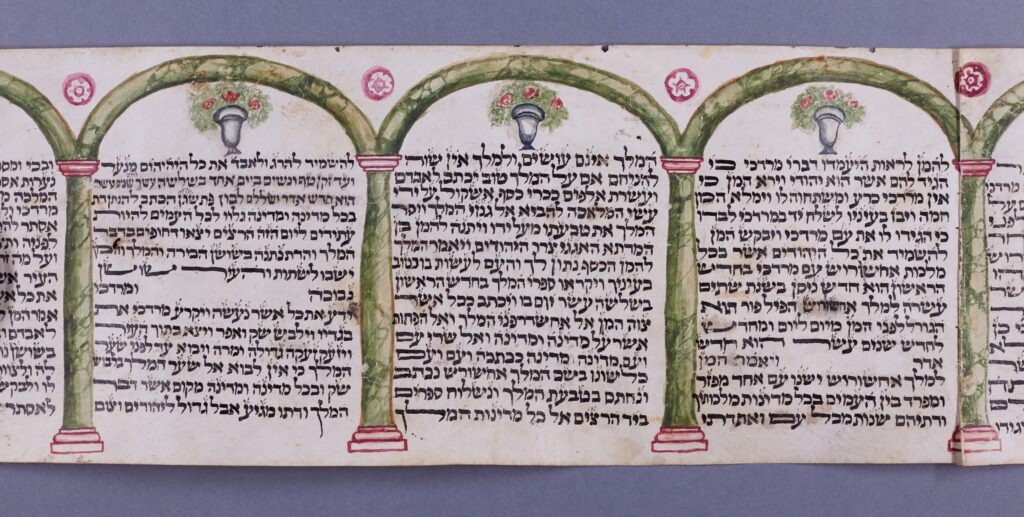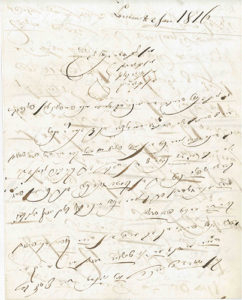An introduction to Jewish terminology for cataloguing
Ketubah of Mac and Ruth Goldsmith 1936, University of Sussex Library
Jewish material found in archives, libraries and museums present unique challenges to those working with them including cultural considerations, language and ritual practice. The aim of this workshop was to give archivists in the UK and Europe an introduction to the key concepts they should consider when cataloguing Jewish material in their collections.
Michelle Margolis is the Norman E. Alexander Librarian for Jewish Studies at Columbia University and former President of the Association of Jewish Libraries. She has many years’ experience cataloguing Jewish books and teaching about Judaism.
Michelle gave her top tips for archivists when preparing to catalogue Jewish material as well as a selection of recommended resources to help you find the right terminology…
Cultural knowledge is key
Like any minority community, cultural knowledge will help you understand the Jewish material and ritual objects you may encounter in your collection and improve your catalogue descriptions.
- Your local Jewish community, experts in institutions or reputable online sources should be able to give context to those items you’re not quite sure about and what they’re used for.

Book of Esther • Lambeth Palace Library [MS 1746]
Start unlocking the Hebrew language
Hebrew is the language of many Jewish documents but even if you don’t know your A from your aleph, there are still many things you can look out for.
- Hebrew is written from right to left so will most likely sit differently on a page with the border on the right-hand side.
- Printed Hebrew script (and that used in scrolls and manuscripts) is different to the hand-writing script used for everyday personal items and community records.
- Hebrew letters have an associated numerical value so dates are a series of letters written together (chronograms). The practice of gematria is also commonplace where a numerical value is assigned to a word. Ask an expert to help you decipher these dates.
- Hebrew dates are from the date of creation according to the Hebrew Bible. This is approximately +1240 (but you’ll need to account for Gregorian Reform). Hebcal is a great website to help convert dates.
- Saturday is the last day of the week so days are counted from Sunday e.g. a reference to Day 2 will refer to Monday.
- See an Introduction to the Jewish Calendar by JewishGen.
Jewish records hold metadata

Ketubah of Mac and Ruth Goldsmith 1936, University of Sussex Library
There are a vast range of Jewish records you may come across as an archivist including marriage contracts (ketubot), community record books (pinkassim) and possibly even circumcision books (mohel books).
- These will usually include names, place names and dates – providing you with substantial metadata. HaMapah has a searchable map of Hebrew place names which can be really useful.
- On printed documents this information will usually be handwritten on the document e.g. a ketubah
- Sometimes Hebrew letters will be used to spell out English words
Caring for sacred material
The material contained in your archive may need to be treated differently depending on its purpose and what text it contains.
- Prayer books and sacred materials / objects may need to be cared for and stored in a particular way.
- A scribal expert can help date scrolls and provide information on where it was written.
- Sacred materials will also need to be discarded in an appropriate way and it’s best to consult a religious authority in these instances e.g. a Rabbi.
Look for other clues

Judendeutsch letter • The Rothschild Archive
- Cultural markers could help determine context. An illustration of a candelabra (menorah) with 7 or 9 branches could tell you whether the item is connected to Chanukah or used for another purpose.
- Photographs often hold important contextual information – for instance people wearing fancy dress might be celebrating the festival of Purim.
- Hebrew isn’t the only Jewish language. Whether a document is written in Yiddish, Judaeo-German or Judeo-Spanish (Ladino) could change the cultural context of the material.
The following list of resources is a good place to start if you’re looking for information…
Online Resources:
Hebcal: https://www.hebcal.com/
HaMapah map of Hebrew placenames: https://blog.hamapah.org/searchable-map-of-hebrew-place-names/
Caring for Judaica by Margalit Schindler: https://connectingtocollections.org/care_of_judaica/
The Book of Hebrew Script: History, Palaeography, Script Styles, Calligraphy & Design by Ada Yardeni (difficult to get hold of but a great resource) https://www.goodreads.com/book/show/2287379.The_Book_of_Hebrew_Script
Organisations and associations:
‘Ask an expert’ feature on Hidden Treasures: https://celebratingjewisharchives.org/ask-an-expert/
Hebraica Libraries’ Group: https://hebraicalibraries.wordpress.com
Association of Jewish Libraries: https://jewishlibraries.org/
For more detailed cataloguing guidance:
AJL’s Research, Archives and Special Libraries Cataloging Committee Wiki: http://rascat.pbworks.com/w/page/7836007/Home (see also “General Resources”)
Princeton Transliteration Guide: https://libguides.princeton.edu/c.php?g=1386025&p=10249841